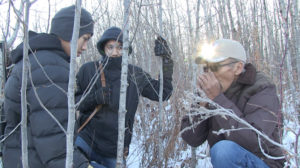Nimosôm “my grandfather,” documentary premieres at the imagineNATIVE Film Festival

By Rick Garrick
KEHEWIN CREE NATION — Nimosôm “my grandfather,” a short documentary that premiered at the imagineNATIVE Film Festival on Oct. 19, highlights the authentic narrative traditional relationship between two youth and their Nimosôm in a Cree community in Alberta. The 18-minute film, directed by Anishinaabe filmmaker Bruce Barry, features Layne YoungChief and Dylan John and their late grandfather Gabriel John, all from Kehewin Cree Nation.
“We started the film 10 years ago and it was with the idea that we would update it down the road,” says Barry, a Sandy Bay citizen and director development and creative affairs at Achimok Productions Inc. “We had two producers, George Porter and Mabel Howse. Mabel Howse was my spouse and she walked on from this world last October 1, so we didn’t get it finished in the fall of 2021, but we did since then, because the whole idea when we started 10 years ago was we would film the grandfather teaching the boys and then update the impact on the boys 10 years later.”
Barry says one of the youth now has a daughter and they are both teaching and passing on their knowledge to other youth in the community.
“There is a whole collection of Anishinaabe who live in the city and for a variety of reasons don’t get exposed to this,” Barry says. “So in a way it is education for the youth and those who have been disconnected about Anishinaabe life, and harvesting moose is a really important part of it.”
Glen YoungChief, executive producer of Nimosôm and Kehewin Cree citizen, says the film highlights oral history and the passing down of knowledge.
“It’s part of reconciliation, we want people to understand this and what we’re trying to go back to,” YoungChief says. “We’re trying to go home to our original ways and thoughts as close as possible. In regards to oral history and the passing down of knowledge, that has been our ways for generations upon generations. Hearing [the grandfather] speak the Cree language, we’re using modern technology to enhance and maintain the language also.”
Barry says the film shows the “real affection” between the grandfather and the two youth.
“And they talk about that in the film too, and it really is a story of affection, caring, passing on knowledge, authentic narrative between generations,” Barry says. “Unless you were raised like we both were in an Indigenous community, you don’t understand how interwoven the tapestry is [among the] generations, and we really wanted to show that and to capture that.”
Barry says the film also highlights how hunting is not a sport or hobby in a First Nation.
“For a lot of people, if you don’t get a moose you’re not having much meat this winter, and I think that’s important to get across to the non-Indigenous community,” Barry says, noting that his grandson shared a quarter of his moose with the Elders. “Otherwise they’d have no moose meat in the winter — and we really wanted to emphasize that.”
Barry says people who watched the premiere of the film at the imagineNATIVE Film Festival liked its authenticity.
“The other feedback we’ve gotten is that it reaffirmed for them this importance of passing language [and] tradition between the generations,” Barry says. “A lot of people say: ‘I really like this because it’s an authentic narrative between the generations, like generations talking to each other.’ One guy says watching the whole film is worth it just to hear Gabe call moose, because he [was] when he was in this world a really talented moose caller.”


